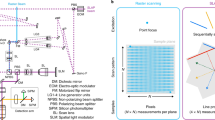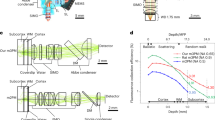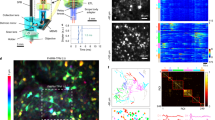Abstract
Developments in miniaturized microscopes have enabled visualization of brain activities and structural dynamics in animals engaging in self-determined behaviors. However, it remains a challenge to resolve activity at single dendritic spines in freely behaving animals. Here, we report the design and application of a fast high-resolution, miniaturized two-photon microscope (FHIRM-TPM) that accomplishes this goal. With a headpiece weighing 2.15 g and a hollow-core photonic crystal fiber delivering 920-nm femtosecond laser pulses, the FHIRM-TPM is capable of imaging commonly used biosensors (GFP and GCaMP6) at high spatiotemporal resolution (0.64 μm laterally and 3.35 μm axially, 40 Hz at 256 × 256 pixels for raster scanning and 10,000 Hz for free-line scanning). We demonstrate the microscope's robustness with hour-long recordings of neuronal activities at the level of spines in mice experiencing vigorous body movements.
This is a preview of subscription content, access via your institution
Access options
Access Nature and 54 other Nature Portfolio journals
Get Nature+, our best-value online-access subscription
$29.99 / 30 days
cancel any time
Subscribe to this journal
Receive 12 print issues and online access
$259.00 per year
only $21.58 per issue
Buy this article
- Purchase on Springer Link
- Instant access to full article PDF
Prices may be subject to local taxes which are calculated during checkout




Similar content being viewed by others
Change history
20 June 2017
In the version of this article initially published online, the affiliation for Aimin Wang was incorrectly listed as Department of Neurobiology, Institute of Basic Medical Sciences, Beijing, China. The correct affiliation is State Key Laboratory of Advanced Optical Communication System and Networks, School of Electronics Engineering and Computer Science, Peking University, Beijing, China. The error has been corrected in the print, PDF and HTML versions of this article.
References
Niell, C.M. & Smith, S.J. Live optical imaging of nervous system development. Annu. Rev. Physiol. 66, 771–798 (2004).
Alvarez, V.A. & Sabatini, B.L. Anatomical and physiological plasticity of dendritic spines. Annu. Rev. Neurosci. 30, 79–97 (2007).
Kerr, J.N. & Denk, W. Imaging in vivo: watching the brain in action. Nat. Rev. Neurosci. 9, 195–205 (2008).
Chen, C.C., Lu, J. & Zuo, Y. Spatiotemporal dynamics of dendritic spines in the living brain. Front. Neuroanat. 8, 28 (2014).
Aghajan, Z.M. et al. Impaired spatial selectivity and intact phase precession in two-dimensional virtual reality. Nat. Neurosci. 18, 121–128 (2015).
Minderer, M., Harvey, C.D., Donato, F. & Moser, E.I. Neuroscience: virtual reality explored. Nature 533, 324–325 (2016).
Jercog, P., Rogerson, T. & Schnitzer, M.J. Large-scale fluorescence calcium-imaging methods for studies of long-term memory in behaving mammals. Cold Spring Harb. Perspect. Biol. 8, a021824 (2016).
Helmchen, F., Fee, M.S., Tank, D.W. & Denk, W. A miniature head-mounted two-photon microscope: high-resolution brain imaging in freely moving animals. Neuron 31, 903–912 (2001).
Fu, L. & Gu, M. Double-clad photonic crystal fiber coupler for compact nonlinear optical microscopy imaging. Opt. Lett. 31, 1471–1473 (2006).
Jung, W. et al. Miniaturized probe based on a microelectromechanical system mirror for multiphoton microscopy. Opt. Lett. 33, 1324–1326 (2008).
Piyawattanametha, W. et al. In vivo brain imaging using a portable 2.9 2.9 g two-photon microscope based on a microelectromechanical systems scanning mirror. Opt. Lett. 34, 2309–2311 (2009).
Rivera, D.R. et al. Compact and flexible raster scanning multiphoton endoscope capable of imaging unstained tissue. Proc. Natl. Acad. Sci. USA 108, 17598–17603 (2011).
Sawinski, J. et al. Visually evoked activity in cortical cells imaged in freely moving animals. Proc. Natl. Acad. Sci. USA 106, 19557–19562 (2009).
Zhang, Y. et al. A compact fiber-optic SHG scanning endomicroscope and its application to visualize cervical remodeling during pregnancy. Proc. Natl. Acad. Sci. USA 109, 12878–12883 (2012).
Ghosh, K.K. et al. Miniaturized integration of a fluorescence microscope. Nat. Methods 8, 871–878 (2011).
Sofroniew, N.J., Flickinger, D., King, J. & Svoboda, K. A large field of view two-photon mesoscope with subcellular resolution for in vivo imaging. eLife 5, e14472 (2016).
Göbel, W., Nimmerjahn, A. & Helmchen, F. Distortion-free delivery of nanojoule femtosecond pulses from a Ti:sapphire laser through a hollow-core photonic crystal fiber. Opt. Lett. 29, 1285–1287 (2004).
Drobizhev, M., Makarov, N.S., Tillo, S.E., Hughes, T.E. & Rebane, A. Two-photon absorption properties of fluorescent proteins. Nat. Methods 8, 393–399 (2011).
Chen, T.W. et al. Ultrasensitive fluorescent proteins for imaging neuronal activity. Nature 499, 295–300 (2013).
Niell, C.M. & Stryker, M.P. Modulation of visual responses by behavioral state in mouse visual cortex. Neuron 65, 472–479 (2010).
Saleem, A.B., Ayaz, A., Jeffery, K.J., Harris, K.D. & Carandini, M. Integration of visual motion and locomotion in mouse visual cortex. Nat. Neurosci. 16, 1864–1869 (2013).
Sekiguchi, K.J. et al. Imaging large-scale cellular activity in spinal cord of freely behaving mice. Nat. Commun. 7, 11450 (2016).
Hochbaum, D.R. et al. All-optical electrophysiology in mammalian neurons using engineered microbial rhodopsins. Nat. Methods 11, 825–833 (2014).
Gong, Y. et al. High-speed recording of neural spikes in awake mice and flies with a fluorescent voltage sensor. Science 350, 1361–1366 (2015).
Prakash, R. et al. Two-photon optogenetic toolbox for fast inhibition, excitation and bistable modulation. Nat. Methods 9, 1171–1179 (2012).
Rickgauer, J.P., Deisseroth, K. & Tank, D.W. Simultaneous cellular-resolution optical perturbation and imaging of place cell firing fields. Nat. Neurosci. 17, 1816–1824 (2014).
Kerr, J.N. & Nimmerjahn, A. Functional imaging in freely moving animals. Curr. Opin. Neurobiol. 22, 45–53 (2012).
Chen, X., Leischner, U., Rochefort, N.L., Nelken, I. & Konnerth, A. Functional mapping of single spines in cortical neurons in vivo. Nature 475, 501–505 (2011).
Jia, H., Rochefort, N.L., Chen, X. & Konnerth, A. Dendritic organization of sensory input to cortical neurons in vivo. Nature 464, 1307–1312 (2010).
Bocarsly, M.E. et al. Minimally invasive microendoscopy system for in vivo functional imaging of deep nuclei in the mouse brain. Biomed. Opt. Express 6, 4546–4556 (2015).
Attardo, A., Fitzgerald, J.E. & Schnitzer, M.J. Impermanence of dendritic spines in live adult CA1 hippocampus. Nature 523, 592–596 (2015).
Zong, W. Assembly of a miniature two-photon microscope headpiece. Protocol Exchange http://dx.doi.org/10.1038/protex.2017.048 (2017).
Cichon, J. & Gan, W.-B. Branch-specific dendritic Ca2+ spikes cause persistent synaptic plasticity. Nature 520, 180–185 (2015).
Garaschuk, O., Milos, R.I. & Konnerth, A. Targeted bulk-loading of fluorescent indicators for two-photon brain imaging in vivo. Nat. Protoc. 1, 380–386 (2006).
Tada, M., Takeuchi, A., Hashizume, M., Kitamura, K. & Kano, M. A highly sensitive fluorescent indicator dye for calcium imaging of neural activity in vitro and in vivo. Eur. J. Neurosci. 39, 1720–1728 (2014).
Resendez, S.L. et al. Visualization of cortical, subcortical and deep brain neural circuit dynamics during naturalistic mammalian behavior with head-mounted microscopes and chronically implanted lenses. Nat. Protoc. 11, 566–597 (2016).
Lucas, B.D. & Kanade, T. in International Joint Conference on Artificial Intelligence 285–289 (1981).
Acknowledgements
We thank X. Li, D. Li, X. Chen, Z. Zhang, W. Gan, Y. Sun, S. Wang, and X. Chen for comments on the optics and biological experiments, and I.C. Bruce for manuscript editing. We also thank Mirrorcle Technologies for assistance with MEMS design and fabrication. The work was supported by grants from the National Natural Science Foundation of China (31327901, 31521062, 3142800018, and 31570839), the Major State Basic Research Program of China (2013CB531200 and 2012CB518200), and the National Science and Technology Major Project Program (2016YFA0500400).
Author information
Authors and Affiliations
Contributions
H.C., W.Z., and L.C. conceived the project; H.C. and L.C. supervised the research; W.Z. designed and built the system; W.Z., R.W., and M.L. performed the experiments; R.W. wrote the control software, and Y.H. made electronic circuits under the supervision of Y.Z.; A.W. and Y. Li oversaw fiber optics and assisted with mechanical assembly; H.R., Y.X., and J.L. performed the mechanical fabrication; H.W. and M.F. supplied the indicator mice; M.L. prepared the biological samples under the supervision of Z.Z.; W.Z., M.L., Y. Lu, and J.L. analyzed data; H.C., W.Z., L.C., and H.J. wrote the paper. All authors participated in discussions and data interpretation.
Corresponding authors
Ethics declarations
Competing interests
The authors declare no competing financial interests.
Integrated supplementary information
Supplementary Figure 1 Comparison of two-photon excitation efficiency of GCaMP-6f at 800-nm, 920-nm, and 1,030-nm excitation.
(a) Imaging the same sets of neuronal somata in an AAV-transfected mouse expressing GCaMP-6f in V-1 cortex at different excitation wavelengths. (b)-(d) Frequencies (b), amplitudes (c), and averaged time courses (d) of Ca2+ transients from ten somata shown in (a). (e) As in (a), except for imaging neuronal dendrites at a different focal plane. (f)-(h) Frequencies (f), amplitudes (g), and average time courses (h) of Ca2+ transients from ten dendrites shown in (e). Imaging parameters are shown in Supplementary Table S6.
Supplementary Figure 2 Dispersion compensation of the HC-920.
(a) Schematic for compensation of the HC-920 dispersion with an H-ZF62 glass tube. (b) Dispersion parameter of the glass H-ZF62. (c) Pulse-width of the 920-nm femtosecond laser output from a 1-m HC-920 without dispersion compensation. (d) Pulse-width of the 920-nm femtosecond laser before and after a 1-m HC-920 with and without dispersion compensation. See Supplementary Note 1 for details.
Supplementary Figure 3 Optical design of the FHIRM-TPM.
(a) Illumination arm of the FHIRM-TPM. Upper: on-axis excitation light path from the output of the HC-920 to the specimen. Middle: off-axis scanning light path from the surface of the MEMS to the specimen. Lower: schematic of the high NA achromatic miniature compound objective assembly. (b) Detection arm of the FHIRM-TPM. Left: without the collection lens, some of the emission light at the edge of a large FOV (130 μm) is lost. Right: The collection lens relays all emission light within the FOV onto the SFB. See details in Supplementary Note 2.
Supplementary Figure 4 Possible effect of the carried headpiece on mouse movement.
(a) Snapshots from videos captured by the camera showing a representative mouse without (left) or with the FHIRM-mTPM mounted on its head (right). Trajectories extracted from these videos are presented in the below. The speed of movement is coded in color. (b) Average moving speed (left) and total travel distance (right) of mice with and without the FHIRM-mTPM. Data are presented as box-and-whisker plot from 8 mice with or without FHIRM-TPM. Two-tailed paired t-test. p for speed = 0.103. p for distance = 0.324.
Supplementary Figure 5 An integrated platform for comparing the performance of benchtop TPM, miniature wide-field microscope, and FHIRM-TPM.
(a) 3D schematic of excitation ligh path for benchtop TPM and FHIRM-TPM. HWP: half wave plate; AOM: acoustic-optics modulator; PBS: polarization beam splitter. (b) Optical diagram of the light path shown in (a). (c)-(e) Schematic of the light path of the real setup switchable among a benchtop TPM (c, d), a miniature wide-field fluorescence microscope (e, f), and an FHIRM-TPM (g, h). See more details in Supplementary Note 3.
Supplementary Figure 6 Comparison of dendrite activities in V1 cortex under head-fixed and freely moving conditions in a mouse in a dark arena.
(a): 50-s-averaged FHIRM-TPM image of V-1 cortical L2/3 neurons. (b): Two-dimensional trajectories of the mouse within the arena (duration: 100 s). Traces were calculated from video records captured by camera-1, and movement speeds are color-coded. (c) and (d): Time courses (duration: 100 s) of Ca2+ transients from three dendrites (circled in a) under head-fixed (c) and freely-moving conditions (d). Time-dependent change in the speed of the mouse is also shown at the bottom. (e): Average frequencies of all dendritic Ca2+ transients under head-fixed and free-moving conditions. Data are presented as box-and-whisker plot from15 dendrites. Two-tailed paired t-test. *** p <0.001.
Supplementary Figure 7 Preliminary results of the mTPM equipped with another customized miniature optical objective.
Left: Cortical neurons of a mouse were loaded with Cal-520, and imaged with the FHIRM-TPM equipped with another customized miniature objective (NA 0.7, Domilight, China) under head-fixed conditions. A FOV of 170 ×170 mm2 was achieved. Right: Representative Ca2+ transients from selected 4 somata shown in left image. The image speed was 20 Hz and the image depth was 150 mm with a 170-μm-thickness coverslip.
Supplementary Figure 8 How to mount the headpiece onto the head of a mouse.
(a) Left, the scheme of the home-made chamber. Right, the photo of a mouse mounted with the chamber and cranial window. (b) The step-by-step schematics of how to mount the microscope onto the head of the mouse. Step 1, the cranial window (coverglass) was removed from the skull and a drop of ACSF was placed on the surface of the exposed brain tissue. Step 2, we moved the microscope with a 3-axial motorized stage, and continuously imaged until the interested ROI identified. The holder was pulled up during this stage. Step 3, we moved the holder down to attach to the chamber. Step 4, we injected glue to the edge of the holder to stabilize the holder and the chamber. Next, we fastened two screws to tightly connect the holder to the microscope. Step 5, we put a drop of 1.5% agarose around the end of the objective and the surface of the brain. (c) Positions of the objective and the agarose in different conditions. Left: Upon imaging the superficial tissue (0~150 μm) without the coverglass, the gap between the objective and the surface of the brain was filled with the agarose. Middle: Upon imaging the deep tissue (more than 150 μm) without the coverglass, the objective was directly attached the surface of the brain, with the agarose dropped around the objective and the top of the brain. Right: Under the condition of imaging through a coverglass, the agarose was filled in between, and surrounding the objective and the coverglass. Due to the limited working distance of the miniature objective (~200 μm) and the thickness of the coverglass (>100 μm), imaging depth is limited (~0-100 μm for the GRINTECH objective). (d) The shift speed of FOV in head-fixed, free-moving conditions with and without the agarose. Data are presented as box-and-whisker plot from 3 dendrites. ***p <0.001.
Supplementary information
Supplementary Text and Figures
Supplementary Figures 1–8, Supplementary Notes 1–3 and Supplementary Tables 1–6.
Supplementary Data
The technical drawings of the FHIRM-TPM.
Supplementary Protocol
A protocol for the assembly of miniature two-photon microscope headpiece.
41592_2017_BFnmeth4305_MOESM4_ESM.mov
3D morphology of neuronal dendrites and spines imaged with the benchtop TPM, the miniature wide-field fluorescence microscope, and the FHIRM-TPM.
41592_2017_BFnmeth4305_MOESM5_ESM.mov
Ca2+ signals from somata imaged with the benchtop TPM, the miniature wide-field fluorescence microscope, and the FHIRM-TPM.
Rights and permissions
About this article
Cite this article
Zong, W., Wu, R., Li, M. et al. Fast high-resolution miniature two-photon microscopy for brain imaging in freely behaving mice. Nat Methods 14, 713–719 (2017). https://doi.org/10.1038/nmeth.4305
Received:
Accepted:
Published:
Issue Date:
DOI: https://doi.org/10.1038/nmeth.4305
This article is cited by
-
Visualizing cortical blood perfusion after photothrombotic stroke in vivo by needle-shaped beam optical coherence tomography angiography
PhotoniX (2024)
-
A molecularly defined amygdala-independent tetra-synaptic forebrain-to-hindbrain pathway for odor-driven innate fear and anxiety
Nature Neuroscience (2024)
-
Free-moving-state microscopic imaging of cerebral oxygenation and hemodynamics with a photoacoustic fiberscope
Light: Science & Applications (2024)
-
Mesoscopic calcium imaging in a head-unrestrained male non-human primate using a lensless microscope
Nature Communications (2024)
-
BNST GABAergic neurons modulate wakefulness over sleep and anesthesia
Communications Biology (2024)



